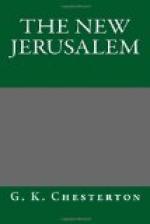Almost any traveller could select out of the countless things that he has looked at the few things that he has seen. I mean the things that come to him with a curious clearness; so that he actually sees them to be what he knows them to be. I might almost say that he can believe in them although he has seen them. There can be no rule about this realisation; it seems to come in the most random fashion; and the man to whom it comes can only speak for himself without any attempt at a critical comparison with others. In this sense I may say that the Church of the Nativity at Bethlehem contains something impossible to describe, yet driving me beyond expression to a desperate attempt at description. The church is entered through a door so small that it it might fairly be called a hole, in which many have seen, and I think truly, a symbol of some idea of humility. It is also said that the wall was pierced in this way to prevent the appearance of a camel during divine service, but even that explanation would only repeat the same suggestion through the parable of the needle’s eye. Personally I should guess that, in so far as the purpose was practical, it was meant to keep out much more dangerous animals than camels, as, for instance, Turks. For the whole church has clearly been turned into a fortress, windows are bricked up and walls thickened in some or all of its thousand years of religious war. In the blank spaces above the little doorway hung in old times that strange mosaic of the Magi which once saved the holy place from destruction, in the strange interlude between the decline of Rome and the rise of Mahomet. For when the Persians who had destroyed Jerusalem rode out in triumph to the village of Bethlehem, they looked up and saw above the door a picture in coloured stone, a picture of themselves. They were following a strange star and worshipping an unknown child. For a Christian artist, following some ancient Eastern tradition containing an eternal truth, had drawn the three wise men with the long robes and high head-dresses of Persia. The worshippers of the sun had come westward for the worship of the star. But whether that part of the church were bare and bald as it is now or coloured with the gold and purple images of the Persians, the inside of the church would always be by comparison abruptly dark. As familiarity turns the darkness to twilight, and the twilight to a grey daylight, the first impression is that of two rows of towering pillars. They are of a dark red stone having much of the appearance of a dark red marble; and they are crowned with the acanthus in the manner of the Corinthian school. They were carved and set up at the command of Constantine; and beyond them, at the other end of the church beside the attar, is the dark stairway that descends under the canopies of rock to the stable where Christ was born.




